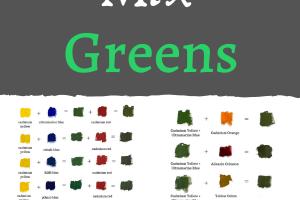Mastering the Art of Mixing Green Paint: A Comprehensive Guide

-
Quick Links:
- Introduction
- Understanding the Color Green
- Basic Color Theory
- Using Primary Colors to Create Green
- Techniques for Mixing Green Shades
- Tools and Materials Needed
- Case Studies: Successful Green Mixes
- Expert Insights on Mixing Paint
- Common Mistakes to Avoid
- FAQs
Introduction
Mixing different shades of green paint can be an enjoyable and rewarding experience, whether you're an artist, a DIY enthusiast, or a professional painter. The versatility of green makes it a popular choice in various applications, from home décor to fine art. In this comprehensive guide, you'll learn the fundamentals of mixing green paint, explore techniques, and discover expert tips to achieve the perfect shade for your project.
Understanding the Color Green
Green is often associated with nature, symbolizing growth, harmony, and freshness. From the soft pastels of spring to the deep, rich tones of a forest, green encompasses a wide range of hues. Understanding the nuances of green will help you create the specific shade you desire.
Different Shades of Green
- Mint Green
- Olive Green
- Forest Green
- Lime Green
- Seafoam Green
Basic Color Theory
To effectively mix green paint, it's essential to grasp basic color theory. Colors are often categorized into three main types: primary, secondary, and tertiary colors.
Primary Colors
The primary colors are red, blue, and yellow. These colors cannot be created by mixing other colors.
Secondary Colors
Secondary colors are created by mixing two primary colors. Green is a secondary color, achieved by mixing blue and yellow.
Tertiary Colors
Tertiary colors are created by mixing a primary color with a secondary color, resulting in hues like teal and lime.
Using Primary Colors to Create Green
To create green paint, you'll need to mix blue and yellow. The ratio of each color will determine the shade of green:
- More Yellow: Adds warmth, resulting in a brighter or more lime-like green.
- More Blue: Creates a cooler, darker green, reminiscent of pine or forest shades.
Techniques for Mixing Green Shades
Mixing paint can be a straightforward process, but employing the right techniques can enhance your results.
1. Start Small
Begin by mixing small amounts of paint until you achieve the desired shade. This prevents waste and allows for easier adjustments.
2. Use a Palette Knife
A palette knife provides a more uniform mix compared to a brush, ensuring that the colors blend smoothly.
3. Test on Paper
Before applying mixed paint to your project, test the shade on a piece of paper or a scrap surface to see how it looks when dry.
Tools and Materials Needed
Essential Tools
- Palette Knife
- Mixing Palette
- Measuring Cups
- Paintbrushes
- Paper or Canvas for Testing
Paint Types
- Acrylic Paint
- Oil Paint
- Watercolor Paint
Case Studies: Successful Green Mixes
Here are a few case studies that demonstrate successful mixing of green shades in various projects:
1. Interior Design Project
A designer mixed a warm olive green for a kitchen renovation, using a 2:1 ratio of yellow to blue, achieving a cozy, inviting atmosphere.
2. Art Installation
An artist created a series of landscape paintings using various green shades by experimenting with different blue and yellow ratios, showcasing the beauty of nature.
Expert Insights on Mixing Paint
Experts recommend understanding the color wheel for better mixing results. Familiarity with complementary colors can also enhance your palette, creating more dynamic and beautiful shades of green.
Common Mistakes to Avoid
- Not experimenting with ratios before applying paint.
- Using too much pigment at once, leading to unmanageable mixes.
- Forgetting to test the color on a sample surface.
FAQs
1. What colors make different shades of green?
Mix blue and yellow to create various shades of green; adjust the ratio for desired warmth or coolness.
2. How do I create a dark green?
Mix more blue into your green mix to darken the shade.
3. Can I mix green paint with other colors?
Yes, you can mix green with other colors to create unique shades, but be cautious as it may muddy the color.
4. What is the best way to store mixed paint?
Store mixed paint in airtight containers to prevent drying out and maintain consistency.
5. How do I lighten a green shade?
Add white paint to your green mix gradually to achieve a lighter shade.
6. What is the difference between warm and cool greens?
Warm greens contain more yellow, while cool greens have more blue.
7. How can I create a pastel green?
Add white paint to your desired green shade to achieve a pastel look.
8. Is it possible to create green without yellow?
While yellow is essential for traditional green, using other colors like cyan and blue can create variations.
9. How do I match a specific green shade?
Research the color code or sample and experiment with small amounts of blue and yellow until you achieve the match.
10. Can I use food coloring to mix green shades?
Yes, food coloring can be used for crafts and projects, but it's not ideal for painting surfaces.
Conclusion
Mixing different shades of green paint can be a creative and fulfilling endeavor. With the right tools, techniques, and understanding of color theory, you can achieve stunning results for your projects. Don't hesitate to experiment and trust your instincts—every mix is an opportunity for new discoveries!
External References
Random Reads
- The ultimate guide to babymaking in fallout shelter
- How to unlock your nokia cell phone for free
- How to unsend an email
- Mastering computer networking
- Mastering command strips
- Ultimate guide disassembling ps3 fat cleaning
- How to turn turbo boost on intel
- How to turn steam online
- How to install puppy linux
- How to repair laminate flooring